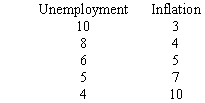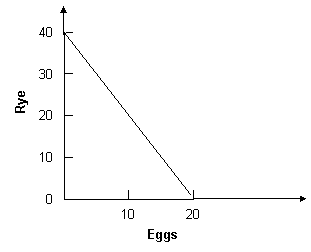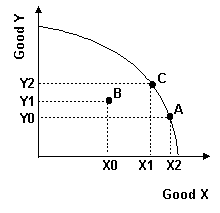 |
1 |  | 
Each of the following rows represents the choice faced by policy makers given the current set of U.S. institutions and technology. What is the opportunity cost of reducing unemployment from 5 percent to 4 percent?
 <a onClick="window.open('/olcweb/cgi/pluginpop.cgi?it=gif::::/olc/dl/107057/Image10.gif','popWin', 'width=255,height=173,resizable,scrollbars');" href="#"><img valign="absmiddle" height="16" width="16" border="0" src="/olcweb/styles/shared/linkicons/image.gif"> (1.0K)</a> <a onClick="window.open('/olcweb/cgi/pluginpop.cgi?it=gif::::/olc/dl/107057/Image10.gif','popWin', 'width=255,height=173,resizable,scrollbars');" href="#"><img valign="absmiddle" height="16" width="16" border="0" src="/olcweb/styles/shared/linkicons/image.gif"> (1.0K)</a> |
|  | A) | 1 percentage point of unemployment. |
|  | B) | 3 percentage points of unemployment. |
|  | C) | 3 percentage points of inflation. |
|  | D) | 1 percentage point of inflation. |
 |
 |
2 |  | 
 <a onClick="window.open('/olcweb/cgi/pluginpop.cgi?it=gif::::/olc/dl/107057/Image11.gif','popWin', 'width=361,height=322,resizable,scrollbars');" href="#"><img valign="absmiddle" height="16" width="16" border="0" src="/olcweb/styles/shared/linkicons/image.gif"> (2.0K)</a> <a onClick="window.open('/olcweb/cgi/pluginpop.cgi?it=gif::::/olc/dl/107057/Image11.gif','popWin', 'width=361,height=322,resizable,scrollbars');" href="#"><img valign="absmiddle" height="16" width="16" border="0" src="/olcweb/styles/shared/linkicons/image.gif"> (2.0K)</a>
Refer to the graph above. The graph indicates that with the resources and technology it has available, Ricardia: |
|  | A) | can produce both 20 units of rye and 10 units of eggs. |
|  | B) | can produce both 40 units of rye and 20 units of eggs. |
|  | C) | cannot produce both 20 units of rye and 10 units of eggs. |
|  | D) | cannot produce both 10 units of rye and 10 units of eggs. |
 |
 |
3 |  | 
The principle of increasing marginal opportunity costs states that initial opportunity costs are __________ and they __________ the more you concentrate on the activity |
|  | A) | high; decrease |
|  | B) | low; increase |
|  | C) | high; increase |
|  | D) | low; decrease |
 |
 |
4 |  | 
 <a onClick="window.open('/olcweb/cgi/pluginpop.cgi?it=gif::::/olc/dl/107057/Image12.gif','popWin', 'width=270,height=283,resizable,scrollbars');" href="#"><img valign="absmiddle" height="16" width="16" border="0" src="/olcweb/styles/shared/linkicons/image.gif"> (2.0K)</a> <a onClick="window.open('/olcweb/cgi/pluginpop.cgi?it=gif::::/olc/dl/107057/Image12.gif','popWin', 'width=270,height=283,resizable,scrollbars');" href="#"><img valign="absmiddle" height="16" width="16" border="0" src="/olcweb/styles/shared/linkicons/image.gif"> (2.0K)</a>
Refer to the graph above. We can infer from the graph that this society: |
|  | A) | prefers B to C. |
|  | B) | prefers C to B. |
|  | C) | is indifferent between C and B. |
|  | D) | is not using its resources efficiently. |
 |
 |
5 |  | 
An improvement in technology will: |
|  | A) | imply that the law of increasing costs no longer applies. |
|  | B) | shift the production possibilities curve inward. |
|  | C) | shift the production possibilities curve outward. |
|  | D) | have no effect on the production possibilities curve. |
 |
 |
6 |  | 
Suppose a country has a comparative advantage in the production of bananas and a comparative disadvantage in the production of pears. In this case, which of the following production patterns will produce the greatest benefits from trade for this country? |
|  | A) | 160 pounds of bananas and 40 pounds of pears. |
|  | B) | 120 pounds of bananas and 80 pounds of pears. |
|  | C) | 80 pounds of bananas and 120 pounds of pears. |
|  | D) | 40 pounds of bananas and 160 pounds of pears. |
 |
 |
7 |  | 
Mexico has a comparative advantage in producing corn: |
|  | A) | if its opportunity cost of producing corn is higher than the opportunity cost in other countries. |
|  | B) | if its opportunity cost of producing corn is the same as the opportunity cost in other countries. |
|  | C) | if its opportunity cost of producing corn is lower than the opportunity cost in other countries. |
|  | D) | regardless of the opportunity cost in other countries. |
 |
 |
8 |  | 
In general, international trade: |
|  | A) | is more difficult to conduct than domestic trade. |
|  | B) | is as difficult to conduct as domestic trade. |
|  | C) | is less difficult to conduct than domestic trade. |
|  | D) | is no different from domestic trade. |
 |
 |
9 |  | 
Assuming government's goal is to benefit society as much as possible, which of the following statements is true? |
|  | A) | Actions with negative and positive externalities should be encouraged. |
|  | B) | Actions with negative and positive externalities should be restricted. |
|  | C) | Actions with negative externalities should be encouraged and actions with positive externalities should be restricted. |
|  | D) | Actions with negative externalities should be restricted and actions with positive externalities should be encouraged. |
 |
 |
10 |  | 
When taxation is progressive, the tax rate: |
|  | A) | remains constant as income increases. |
|  | B) | increases as income increases. |
|  | C) | falls as income increases. |
|  | D) | does not depend on income. |
 |